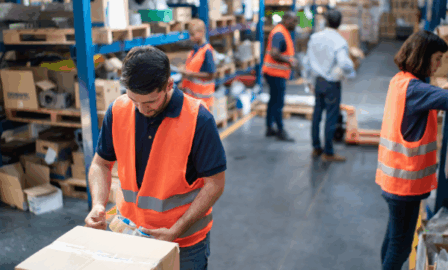Can Blockchain Be Used for Drug Verification?
In 2013, Congress enacted the Drug Supply Chain Security Act (DSCSA) identifying a 10-year roadmap that clearly defined the steps required to make the pharmaceuticals supply chain more secure and transparent and for drug verification. However, the legislation did not instruct the U.S. Food and Drug Administration (FDA) on the use of a certain technological framework.
The legislation stipulates that beginning in November 2020 the authenticity of all products returned to wholesalers, for any reason, should be verifiable as authentic, prior to resale. For example, a wholesaler might inadvertently supply too many or incorrect products.
In the EU, the European Union’s Falsified Medicines Directive, 2011/62/EU, requires all member states to implement product verification procedures and technology. EU pharmacies have been equipped with barcode scanning equipment since February 2019. All prescription medicines now have a unique identifier that consists of a serial number, product code, expiration date, and a batch/lot number. This identifier is printed on the product packaging in readable form, and as a data matrix barcode. Manufacturers route the data in these identifiers to national data repositories via a central European hub so that the authenticity of pharmaceutical products can be verified against it. Using embedded scanning software, pharmacists can check whether a drug product was supplied by the listed manufacturer and is not counterfeit.
Globally, saleable returns account for about two percent of the entire commercial market. That equates to US$7-8 billion (EUR €6-7 billion) every year. The U.S. accounts for more than 40 percent of global pharmaceuticals sales thereby generating gigantic volumes of data. Some pharmaceuticals manufacturers expressed concern about whether a central database would be the right answer to ensure that returned products are not counterfeit before reselling them. Thus, the idea of using a blockchain solution was born. Nine of the 20 largest pharmaceutical companies and two of the three largest wholesalers in the U.S. have now opted for the blockchain solution.
Blockchain Innovation: Four Benefits
Blockchain is ideal for verifying drug products based on the following features:
- Security: Once written on a blockchain, content cannot be changed or deleted. It can only be appended.
- Distribution: Data is easy to distribute in the blockchain.
- Data protection: No personal data, such as patient data, is exchanged, only product data.
- Effort: The infrastructure can be quickly set-up.
Blockchain: Core Concepts
The principle is simple. Each saleable unit is verified using a scanner. An algorithm uses the data matrix code printed on the package, consisting of the product code, batch or lot number, expiration date, and serial number, to create a “hash” – a 64-digit chain of letters and numbers that cannot be changed. A block can be added to the chain provided that the original information is not altered.
For example, a wholesaler scans the returned products to verify their authenticity. Blockchain technology makes it possible to track the journey each product has taken and establish if it can be resold.
Drug Verification with SAP and Blockchain
SAP Information Collaboration Hub for Life Sciences (ICH) is a blockchain product and along with standard SAP Advanced Track and Trace for Pharmaceuticals (ATTP), continues to drive innovation in drug verification. Most recently, SAP has positioned a solution for saleable returns verification capable of mapping the processes reliably and making the solution infinitely scalable – an absolute requirement for the multi-billion-dollar pharmaceuticals market.
The solution can be implemented using MultiChain and delivered using SAP Cloud Platform Blockchain, a fully integrated SAP Cloud Platform component. This integrates blockchain technology into the existing SAP Business Network.
Within MultiChain, streams are created for every lot for which data is written to the blockchain, as the trusted distributed ledger, ensuring validation of the transaction (product commissioning) through a digital signature as well as the verification.
How Does It Work?
The Marketing Authorization Holder (MAH) creates Product Identifier (PI) consisting of product ID (GTIN), batch or lot-ID including expiration date and a randomized unique identifier for the package. This data is printed on the product unit package in a barcode and human readable format.
The hash of the barcode string for every serialized unit is created and written on the blockchain.
A Requester (e.g.-pharmacy or hospital) can easily scan the barcode on the package before the product is sold or administered. A mobile application decodes the barcode, creates a hash of the barcode content and verifies the existence of that exact hash on the blockchain from the network. A warehouse worker at a US wholesaler can also verify a returned saleable product, thus complying with US regulations.
As data cannot be deleted from a blockchain, SAP has taken other measures to avoid excessive growth of the network. SAP separates data into dedicated blockchains by expiration year. A unique blockchain network is established and data is split across these networks according to expiration year. Once an expiration year is passed, products in that chain are no longer saleable, therefore the entire chain can be retired, and is no longer available for verifications. To support mandated data retention requirements, SAP stores expired blockchains for six years after expiry.
Pharmaceutical Blockchain: Potential in COVID-19 treatment accountability
In the current Covid-19 pandemic situation, distribution of medicines for prevention, treatment and cure is of paramount importance. The World Health Organization (WHO) estimates that more than 30 percent of pharmaceutical products dispensed in the developing world such as southeast Asia and central Africa are counterfeit.
Therefore, aid organizations like Médicins Sans Frontières, often use drugs whose origins are unknown. SAP technology infrastructure solves this issue through mobile access to verifiable data.
The benefits of this technology for pharmaceutical companies are two-fold. First, they can contribute to ensuring that fewer counterfeit products reach patients. Additionally, blockchain gives them transparency on how many drugs actually get through to, and are used by, the non-profit organizations in pandemic zones. In addition, blockchain is bursting with potential because it is transferrable to many other industry sectors such as high-tech, retail, and food sectors.
To deliver long-term business benefits, it is imperative that a well-versed strategic execution plan is put in place that will deliver automated verification of authenticity of a product, minimal complexity with maximal security, immutable single source of truth provided to all supply chain network participants, including regulatory authorities and scalability to consumer scanning up to the point of dispense or point of purchase. Blockchain, particularly combined with SAP ATTP is a feasible option for companies looking to comply with drug verification regulations.
Subscribe to Clarkston's Insights
Contributions by Michael Marrone and Don Eberts



